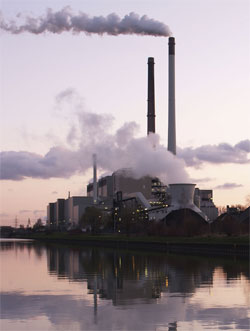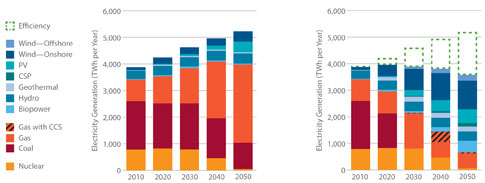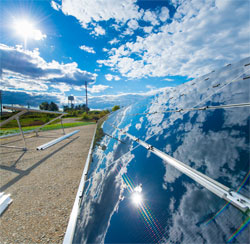Water-Smart Power: Strengthening the U.S. Electricity System in a Warming World
-- A Report of the Energy and Water in a Warming World Initiative (EW3)
We can build an electricity system that protects our water resources and dramatically reduces global warming emissions
 The
country stands at a critical crossroads. Many aging, water-intensive
power plants are nearing the end of their lives. The choices we make to
replace them will determine the water and climate implications of our
electricity system for decades to come.
The
country stands at a critical crossroads. Many aging, water-intensive
power plants are nearing the end of their lives. The choices we make to
replace them will determine the water and climate implications of our
electricity system for decades to come.
Todays electricity system cannot meet our needs in a future of growing demand for power, worsening strains on water resources, and an urgent need to mitigate climate change.
But we can dramatically reduce these water and climate risks by choosing options such as renewable energy and energy efficiency. The key is to understand what a low-carbon, "water-smart" electricity future looks like and to make decisions today that move the country down that path.
Energy-water collisions are happening now, and are poised to worsen in a warming world
The heat waves and drought that hit the U.S. in 2011 and 2012 shined a harsh light on the vulnerability of the U.S. power sector to extreme weather, and revealed water-related electricity risks across the country.
-
 When
plants cannot get enough cooling water, they must cut back or
completely shut down their generators, as happened in 2011 and 2012
at plants around the country.
When
plants cannot get enough cooling water, they must cut back or
completely shut down their generators, as happened in 2011 and 2012
at plants around the country. - Nationally, the 2012 drought was the worst in half a century. Amid soaring temperatures in the Midwest, several power plant operators got permission to discharge exceptionally hot water rather than reduce power output.
- Electricity-water collisions are poised to worsen in a warming world as the power sector helps drive climate change. Extreme weather conditions that have historically been outliers are expected to become standard fare.
The U.S. power sector is undergoing a rapid transformation, which presents a unique opportunity for system-wide change
The biggest shift in half a century is underway in the U.S. power sector, as electricity from coal plants shrinks and power from natural gas and renewables grows.
- In 2008, coal supplied almost half of U.S. electricity. By 2012, that share had dropped to 37 percent, while natural gas and renewable energy together supplied more than 35 percent.
- Decisions about which power plants to retrofit or retire and which kind to build have both near-term and long-term implications, given the long lifetimes of power plants, their carbon emissions, and their water needs.
Replacing coal primarily with natural gas has significant climate and water risks
The U.S. power sector is currently on a "business-as-usual" pathway that would primarily replace coal with natural gas, which is currently projected to supply 60 percent of the country's power by 2050.
-
 This
business-as-usual scenario would do little or nothing to address the
power sector's carbon emissions, which would stay within 5 percent
of current levels through 2050.
This
business-as-usual scenario would do little or nothing to address the
power sector's carbon emissions, which would stay within 5 percent
of current levels through 2050. - Water withdrawals water taken in by power plants for cooling and then released would decline more than 80 percent by 2050 under a business-as-usual scenario. Water consumption water taken in but not returned would drop by more than 40 percent.
- However, these declines in water withdrawals and consumption would occur largely after 2030, a 20-year delay that leaves the power industry unnecessarily vulnerable to drought and exacerbates competition with other water users.

U.S. Electricity Mix
2010-2050
Business-as-Usual Scenario (left) vs. Renewables-and-Efficiency
Scenario (right)
View full-size chart with caption
Focusing instead on water-smart energy choices, such as renewable energy and energy efficiency, would dramatically reduce carbon emissions and water use
The U.S. has the technology and resources to more than meet the projected 2050 growth in electricity demand through improved energy efficiency, and produce 80 percent of the remainder from renewable energy sources.
- In this renewables-and-efficiency scenario, power sector carbon emissions would drop 90 percent below current levels by 2050.
- Water withdrawals would decline 97 percent from current levels by 2050 much more than in a business-as-usual scenario. They would also drop more quickly, with 2030 withdrawals only half as much as a business-as-usual scenario.
- Water consumption would decline 85 percent from current levels by 2050, significantly more than the business-as-usual scenario.
 To
accomplish this and to safeguard our water resources and effectively
address climate change we must make decisions today that prioritize
low-carbon, water-smart options in the U.S. electricity mix.
To
accomplish this and to safeguard our water resources and effectively
address climate change we must make decisions today that prioritize
low-carbon, water-smart options in the U.S. electricity mix.
Fuel and technology options already available provide the means to strengthen the U.S. electricity system. Going forward, electricity decisions should meet water-smart criteria that point decision makers to options that make sense locally, are cost-effective, and reduce both carbon emissions and exposure to water-related risks.
Images (top; middle; bottom): Wikimedia Commons, Arnold Paul; Flickr, Mollivan Jon; Flickr, Argonne National Laboratory
The Union of Concerned Scientists is the leading U.S. science-based nonprofit organization working for a healthy environment and a safer world. Founded in 1969, UCS is headquartered in Cambridge, Massachusetts, and also has offices in Berkeley, Chicago and Washington, D.C. To subscribe or visit go to: http://www.ucsusa.org
http://www.ucsusa.org/clean_energy/our-energy-choices/energy-and-water-use/water-smart-power.html
 CHART:
U.S. Electricity in Transition
CHART:
U.S. Electricity in Transition CHART:
Power Plant Water Use 2010-2050 Business-as-Usual vs.
Renewables-and-Efficiency
CHART:
Power Plant Water Use 2010-2050 Business-as-Usual vs.
Renewables-and-Efficiency